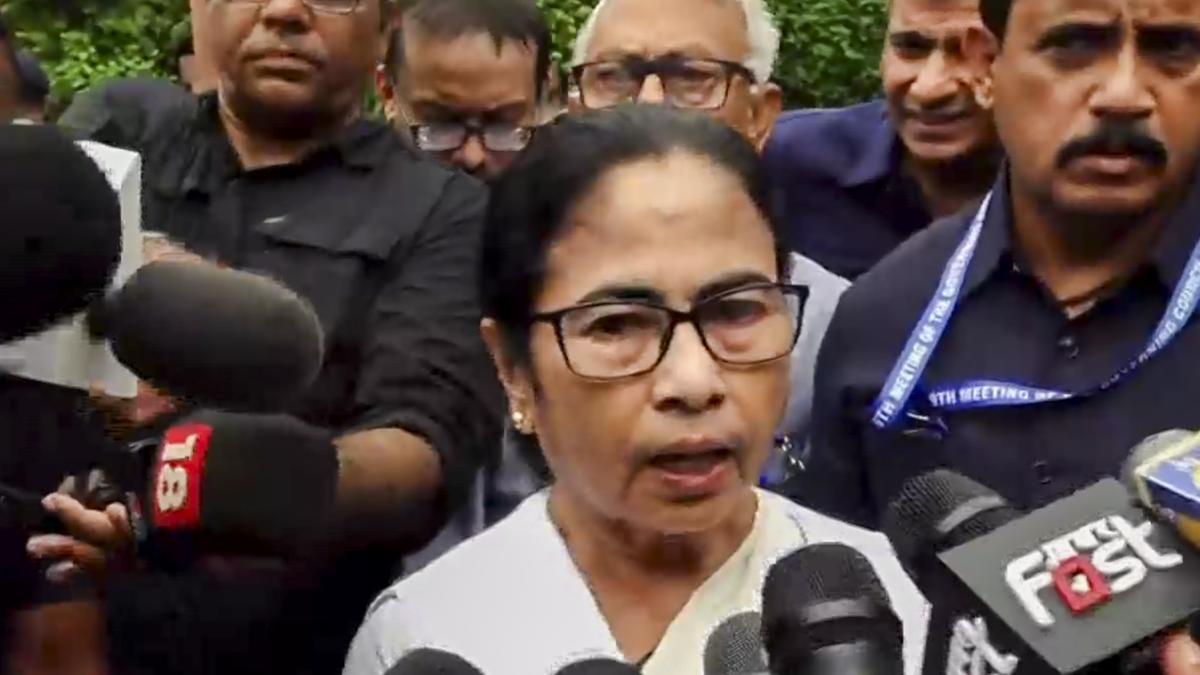West Bengal Chief Minister Mamata Banerjee interacts with the media after walking out of the NITI Aayog meeting in New Delhi.
| Photo Credit: PTI
The 9th governing council meeting of the NITI Aayog on July 27 in New Delhi was boycotted by Chief Ministers of the Opposition INDIA bloc, barring West Bengal Chief Minister Mamata Banerjee, who joined it and later walked out. Of the two Chief Ministers who are critical partners in the ruling National Democratic Alliance (NDA) at the Centre, Bihar Chief Minister Nitish Kumar did not turn up, while his Andhra Pradesh counterpart N. Chandrababu Naidu actively participated in the deliberations. The walk out, absence, and participation, respectively, of Ms. Banerjee, Mr. Kumar, and Mr. Naidu are instructive of the political culture they promote and benefit from, which in turn is tied to the fortunes of the three States they lead.
Editorial | Planning better: On the NITI Aayog
Each Chief Minister had seven minutes to speak. Ms. Banerjee wanted to speak out of turn, and speak early, since she wanted to return to the State in the afternoon. In alphabetical order, West Bengal would have come much later. Her request was granted. Once seven minutes was over, a screen before her showed that time was up, as it happened with all the others before her. Several Chief Ministers had sought more time to speak, which was allowed, but Ms. Banerjee left the meeting in a huff. “I have come out boycotting the meeting. Chandrababu Naidu was given 20 minutes to speak. The Chief Ministers of Assam, Goa, and Chhattisgarh spoke for 10-12 minutes,” she told reporters.
Mr. Naidu spoke for 22 minutes — 15 minutes more than the allotted time — and ignored a note from his own Chief Secretary about the overshot. He elaborated on the developmental challenges before his State and the country, and also the demographic challenges before the country.
Mr. Kumar, who did not attend the meeting, met Janata Dal United leaders from Jharkhand in Patna on the day. According to one account, he was under the weather.
Ms. Banerjee did not want to join the INDIA boycott as her politics is dependent on her maintaining her position as the sole opponent of the Bharatiya Janata Party (BJP) in West Bengal, which in turn is portrayed as anti-Bengal. So, she turned up and made it a solo show of grandstanding.
Mr. Naidu has a reputation of being forceful and persistent in dealing with the Centre. A Minister in the A.B. Vajpayee government, which was then supported by Mr. Naidu’s Telugu Desam Party as the current Modi government is today, would recount how Mr. Naidu would pursue his requests. He would not take no for an answer for a meeting request. Mr. Naidu, who was then the Chief Minister of undivided Andhra Pradesh, would make himself available anytime for the meeting. “No ego, always flexible and persistent in requests for the State,” says a senior official who has seen Mr. Naidu’s functioning over the years.
Mr. Kumar’s absence betrays a lack of interest in governance that percolates from the highest authority to all levels of the administration. Bihar needs Central assistance, arguably more than any other State. The state capacity in Bihar alarmingly low, and its governance should give its administrators sleepless nights. In recent weeks, a dozen or more bridges have collapsed in the State. A recent report of the Comptroller and Auditor General noted that Bihar “spent only ₹2,35,176.84 crore (77.95% of the total Budget) and surrendered ₹20,526.71 crore (30.86%) of the total savings of ₹66,509.62 crore,” for the FY2022-23. The State could not make use of one third of the money it had. Of what it managed to spend, its bridges stand — or fall — in testimony to how the money was spent. Bihar needs to expand its capacity and use the advantage of a friendly government at the Centre to pull itself up from its current situation. But that is unfortunately not happening. Mr. Kumar’s absence is in line with the trend of Bihar officials not attending numerous meetings at the Centre, where projects that are critical for the State are discussed.
These varying governance styles are possibly linked to the politics of these States. In West Bengal and Bihar, the political constituencies built and nurtured by Ms. Banerjee and Mr. Kumar, respectively, have remained insulated from scrutiny based on governance outcomes. They are largely based on serving sectional interests. In Andhra Pradesh, however, no Chief Minister can hope to remain in power without a larger governance vision, though they too have sectional interests to address.
varghese.g@thehindu.co.in

